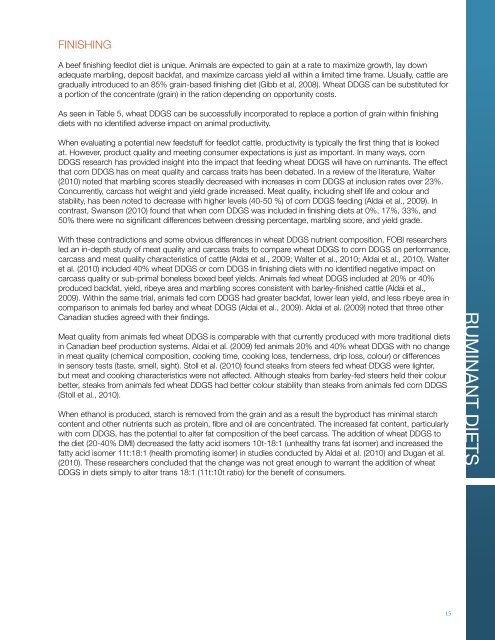Wheat DDGS Feed Guide - Western Canadian Feed Innovation ...
Wheat DDGS Feed Guide - Western Canadian Feed Innovation ...
Wheat DDGS Feed Guide - Western Canadian Feed Innovation ...
Create successful ePaper yourself
Turn your PDF publications into a flip-book with our unique Google optimized e-Paper software.
FINISHING<br />
A beef finishing feedlot diet is unique. Animals are expected to gain at a rate to maximize growth, lay down<br />
adequate marbling, deposit backfat, and maximize carcass yield all within a limited time frame. Usually, cattle are<br />
gradually introduced to an 85% grain-based finishing diet (Gibb et al, 2008). <strong>Wheat</strong> <strong>DDGS</strong> can be substituted for<br />
a portion of the concentrate (grain) in the ration depending on opportunity costs.<br />
As seen in Table 5, wheat <strong>DDGS</strong> can be successfully incorporated to replace a portion of grain within finishing<br />
diets with no identified adverse impact on animal productivity.<br />
When evaluating a potential new feedstuff for feedlot cattle, productivity is typically the first thing that is looked<br />
at. However, product quality and meeting consumer expectations is just as important. In many ways, corn<br />
<strong>DDGS</strong> research has provided insight into the impact that feeding wheat <strong>DDGS</strong> will have on ruminants. The effect<br />
that corn <strong>DDGS</strong> has on meat quality and carcass traits has been debated. In a review of the literature, Walter<br />
(2010) noted that marbling scores steadily decreased with increases in corn <strong>DDGS</strong> at inclusion rates over 23%.<br />
Concurrently, carcass hot weight and yield grade increased. Meat quality, including shelf life and colour and<br />
stability, has been noted to decrease with higher levels (40-50 %) of corn <strong>DDGS</strong> feeding (Aldai et al., 2009). In<br />
contrast, Swanson (2010) found that when corn <strong>DDGS</strong> was included in finishing diets at 0%, 17%, 33%, and<br />
50% there were no significant differences between dressing percentage, marbling score, and yield grade.<br />
With these contradictions and some obvious differences in wheat <strong>DDGS</strong> nutrient composition, FOBI researchers<br />
led an in-depth study of meat quality and carcass traits to compare wheat <strong>DDGS</strong> to corn <strong>DDGS</strong> on performance,<br />
carcass and meat quality characteristics of cattle (Aldai et al., 2009; Walter et al., 2010; Aldai et al., 2010). Walter<br />
et al. (2010) included 40% wheat <strong>DDGS</strong> or corn <strong>DDGS</strong> in finishing diets with no identified negative impact on<br />
carcass quality or sub-primal boneless boxed beef yields. Animals fed wheat <strong>DDGS</strong> included at 20% or 40%<br />
produced backfat, yield, ribeye area and marbling scores consistent with barley-finished cattle (Aldai et al.,<br />
2009). Within the same trial, animals fed corn <strong>DDGS</strong> had greater backfat, lower lean yield, and less ribeye area in<br />
comparison to animals fed barley and wheat <strong>DDGS</strong> (Aldai et al., 2009). Aldai et al. (2009) noted that three other<br />
<strong>Canadian</strong> studies agreed with their findings.<br />
Meat quality from animals fed wheat <strong>DDGS</strong> is comparable with that currently produced with more traditional diets<br />
in <strong>Canadian</strong> beef production systems. Aldai et al. (2009) fed animals 20% and 40% wheat <strong>DDGS</strong> with no change<br />
in meat quality (chemical composition, cooking time, cooking loss, tenderness, drip loss, colour) or differences<br />
in sensory tests (taste, smell, sight). Stoll et al. (2010) found steaks from steers fed wheat <strong>DDGS</strong> were lighter,<br />
but meat and cooking characteristics were not affected. Although steaks from barley-fed steers held their colour<br />
better, steaks from animals fed wheat <strong>DDGS</strong> had better colour stability than steaks from animals fed corn <strong>DDGS</strong><br />
(Stoll et al., 2010).<br />
When ethanol is produced, starch is removed from the grain and as a result the byproduct has minimal starch<br />
content and other nutrients such as protein, fibre and oil are concentrated. The increased fat content, particularly<br />
with corn <strong>DDGS</strong>, has the potential to alter fat composition of the beef carcass. The addition of wheat <strong>DDGS</strong> to<br />
the diet (20-40% DMI) decreased the fatty acid isomers 10t-18:1 (unhealthy trans fat isomer) and increased the<br />
fatty acid isomer 11t:18:1 (health promoting isomer) in studies conducted by Aldai et al. (2010) and Dugan et al.<br />
(2010). These researchers concluded that the change was not great enough to warrant the addition of wheat<br />
<strong>DDGS</strong> in diets simply to alter trans 18:1 (11t:10t ratio) for the benefit of consumers.<br />
15<br />
RUMINANT DIETS


